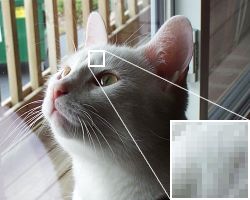Image Resolution and Avoiding Pixellation
 Most images in computerised form are stored
as a series of dots of colour, or pixels. If an image of this kind is enlarged,
at some point the pixels will start to become visible to the naked eye, an
undesirable effect aptly known as pixellation.
Most images in computerised form are stored
as a series of dots of colour, or pixels. If an image of this kind is enlarged,
at some point the pixels will start to become visible to the naked eye, an
undesirable effect aptly known as pixellation.
With some basic arithmetic it is possible to
tell whether an image you want to incorporate into a printed piece will reproduce
satisfactorily, or whether there is a risk of pixellation.
Generally speaking, the minimum resolution
a commercially printed piece of work should be is 300dpi (dots per inch).
That means an image which measures one inch by one inch should have at least 300 rows of 300 dots.
Knowing this figure of 300dpi means you can
calculate the maximum 'safe' size you can reproduce an image.
For example, a 7 MP (megapixel) camera will
produce images of around 3,000 x 2,400 dpi, which translates to a maximum
'safe' size of 10 x 8 inches.
In practice, images can often be reproduced
at a lower resolution, especially on exhibition graphics, banners or posters
where the viewer will not be especially close to the printed piece and therefore
able to spot any pixellation. However, common sense will tell you than an
image the size of a postage stamp cannot be enlarged to the size of a billboard!
Questions
If you have any questions, or would like us
to check if your image will print clearly at the size you intend to reproduce
it, please get in touch using our Design Advice Line on 01457 778788.



